1. Introduction
 Since 1994, Corsair has been leading the race in high-speed RAM modules performance. We had already tested several Corsair products, and they proved to be reliable, stable, and always delivered what they promised. All memory module manufacturers try to make their modules faster and faster, but Corsair, already having their latency clocks reduced to their lowest limits, decided to follow a different approach.
Since 1994, Corsair has been leading the race in high-speed RAM modules performance. We had already tested several Corsair products, and they proved to be reliable, stable, and always delivered what they promised. All memory module manufacturers try to make their modules faster and faster, but Corsair, already having their latency clocks reduced to their lowest limits, decided to follow a different approach.

Corsair was kind enough to send us their latest pair of memory modules, designed and tested to work in Dual Channel mode, with a combined size of 2048MB (1024MB per module). These memory modules come from the Corsair "Platinum Series" and use a large heat spreader that lies on the chipsets. The operating clock is set to 500MHz and the modules are tested at JEDEC standard latency settings (3-4-4-8, 1T).
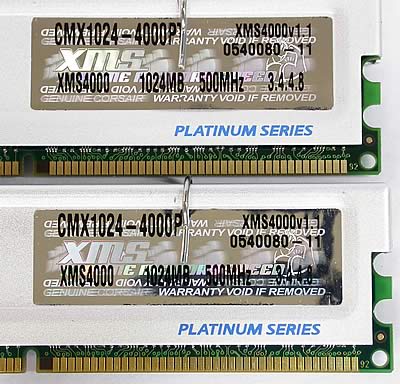
These memory modules use SAMSUNG chipsets that are known for their overclocking potential and reliability. There are 16 chipsets per module (16x64MB).

The modules come in the well known and good looking Corsair thin package.

- Specifications
Below you can see the table with all the specifications for the Corsair TwinX2048-4000PT RAM modules.
| Product Name |
TwinX2048 - 4000PT |
| Package |
2048MB kit (2x1024MB) (dual rank) |
CAS Latency
|
3-4-4-8-1T (JEDEC Standard Latency) |
| Test Voltage |
2.8 V |
| Speed |
DDR 500 MHz (PC4000) |
| Type |
2x 184-pin DDR SDRAM |
| Error Checking |
Non-ECC |
| Registered/Unbuffered |
Unbuffered |
| Manufacturer Warranty |
lifetime warranty |
2. Test System - Configuration
We used an ASUS A8N-SLI Premium and an ASUS A8N-SLI Deluxe motherboard. Both motherboards performed the same, since they use exactly the same ICs (except for the SLI ICs that don't interfere with the RAM modules in any way). After installing the memory in our system, we left the RAM setting to AUTO and we saw that the memory could only operate at 400MHz (2.5-3-3-6).

Of course, the tests could not give us the a true indication if we were to leave the timings as is. As you can see for yourselves, the SPD timings showed that the default operating frequency was 500MHz. So, we had to make some BIOS changes manually, to achieve this frequency.

All we had to do, was to change the CPU Multiplier setting to increase the HTT (thus the RAM frequency), but remain at the default core speed. We also had to manually set the timings, since the system was unstable running at 2.5-3-3-6. Below you can see the true operating frequency and the timings we used for these tests.

The CPU we used was our usual AMD Athlon64 3500+, running at 2200MHz. Using the same processor that we used in all our former reviews will give us the opportunity to compare test results.

However, you should always remember that all other tests we have carried out in the past, were with 1GB memory modules (usually 2x512MB), whereas this time, we will be testing 2GB paired modules (2x1024MB). In this review, we will be comparing the Apacer Real500 Ram Modules with the Corsair XMS TwinX 1024-3200XL. Below you can see the SPD Timings for the Corsair XMS memory modules, according to CPU-Z.
Corsair XMS TwinX 1024-3200XL

Apacer Real500
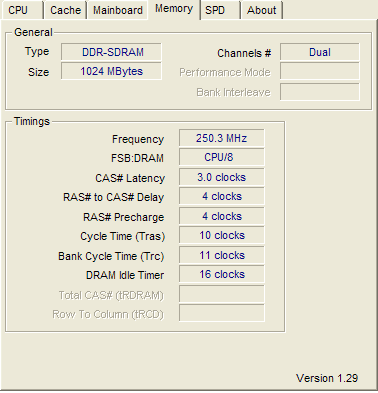
Here's a rundown of our testbed:
System Specifications
CPU: AMD Athlon 64 3500+ CPU (Newcastle)
Case: Antec
Motherboard: ASUS A8N-SLI Deluxe/Premium
Power supply: CoolerMaster 450W
Memory: Corsair TwinX2048-400PT (2x1024MB)
VGA: ASUS 6800GT PCI-E (driver version: 81.95)
Hard Disk Drive: WD800JD 80GB 7200RPM
OS: Windows XP Pro SP2
DirectX: v9.0c


Benchmarks & Applications used
- Memtest86+-1.60
- Sisoft Sandra 2005
- PcMark05
- Performance Test V5.0 ( PassMark)
- Half Life 2 - VST
- CPU-Z v1.30
3. SiSoft Sandra 2005
 SiSoftware Sandra is a 32 and 64-bit Windows system analyser that includes benchmarking, testing and listing modules. It tries to go beyond other utilities to show you more of what is really going on under the hood so you draw comparisons at both a high and low-level in a single product.
SiSoftware Sandra is a 32 and 64-bit Windows system analyser that includes benchmarking, testing and listing modules. It tries to go beyond other utilities to show you more of what is really going on under the hood so you draw comparisons at both a high and low-level in a single product.
You can get information about the CPU, chipset, video adapter, ports, printers, sound card, memory, network, Windows internals, AGP, ODBC Connections, USB2, Firewire etc.
You can save/print/fax/e-mail/post/upload or insert into ADO/ODBC databases reports in text, HTML, XML, SMS/DMI or RPT format.
This version supports multiple sources of information gathering including: remote computers, PDAs, Smart Phones, ADO/ODBC databases or saved system reports.
All benchmarks are optimised for both SMP & SMT (Hyper-Threading), up to 32/64 CPUs depending on the platform.
Memory Bandwidth Benchmark
Tests how your memory sub-system compares to other systems with the same or similar memory in other systems. The benchmark is based on the well-known STREAM memory bandwidth benchmark.
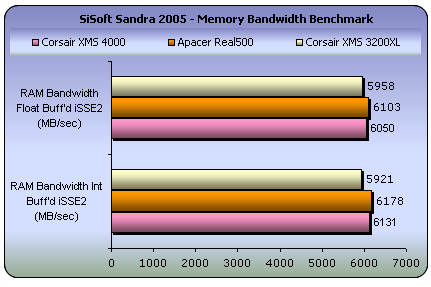
Cache & Memory Benchmark
Tests how your CPU cache and memory sub-system(s) compares to other systems with the same or similar CPU & memory in other systems. The benchmark is based on the Memory Bandwidth Benchmark test.
Combined Index: is a composite figure representing the overall performance rating of the entire Cache-Memory performance in terms of MB/s. The value is the logarithmic average of all the results for the entire address space. (Higher is better, i.e. better performance)
For block sizes that could not been tested - the average of previous blocks is used, thus the size of the memory (as long as it is not comparable to largest cache size) is not significant; all cache sizes are significant - larger caches will result in a higher index.
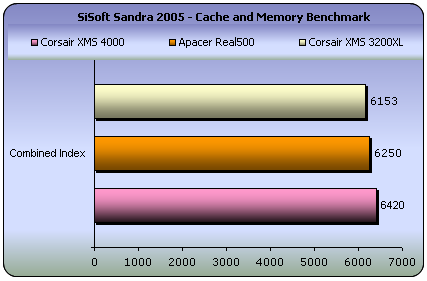
Speed Factor: is a figure representing the speed differential between the CPU’s cache and memory. The value is the ratio of the fastest cache (i.e. L1) bandwidth to the main memory bandwidth. (Lower is better, i.e. the memory is not very much slower than CPU’s cache)
As the factor is a ratio, it is useful only in comparing different CPUs and memory sub-systems rather than having a direct, physical interpretation associated to its numerical value.
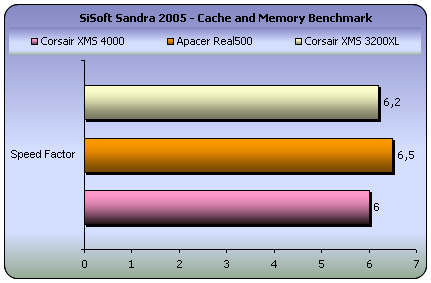
Although the Corsair 2GB memory came second in the SiSoft Memory Bandwidth Benchmark, with the Apacer modules being slightly faster, the Cache and Memory Benchmark indicates the real winner. Both the combined index and speed factor showed that the fastest memory in this comparison were indeed the TwinX 2GB modules. Later on (when discussing the PCMARK05 and PassMark Performance test results) we will reveal why the TwinX2048-4000PT was not the fastest in the Memory Bandwidth Benchmark.

4. PCMark05
 PCMark05 is an application-based benchmark and a premium tool for measuring overall PC performance. It uses portions of real applications instead of including very large applications or using specifically created code. This allows PCMark05 to be a smaller installation as well as to report very accurate results. As far as possible, PCMark05 uses public domain applications whose source code can be freely examined by any user.
PCMark05 is an application-based benchmark and a premium tool for measuring overall PC performance. It uses portions of real applications instead of including very large applications or using specifically created code. This allows PCMark05 to be a smaller installation as well as to report very accurate results. As far as possible, PCMark05 uses public domain applications whose source code can be freely examined by any user.
PCMark05 includes 4 categorized suites for benchmarking your computer. These include CPU, Graphics, Memory and a Hard Disk Drive benchmark. In our case, we selected to run only the Memory test suite.
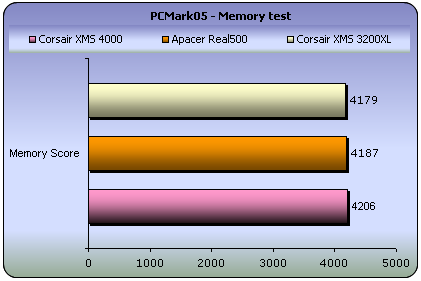
In this test, although all results were similar, the Corsair TwinX2048-4000PT memory was the fastest of the three.
PCMark05
Memory Test |
Corsair TwinX2048 - 4000PT |
Apacer Real500 |
Corsair XMS TWINX1024-3200XL |
| Memory Read 16MB |
5901.163 |
5918.761 |
6018.050 |
| Memory Read 8MB |
6049.526 |
6042.337 |
6146.775 |
| Memory Read 192KB |
10765.924 |
10774.117 |
10808.938 |
| Memory Read 4KB |
27955.679 |
27970.318 |
28036.627 |
| Memory Write 16MB |
5917.826 |
5892.469 |
5920.201 |
| Memory Write 8MB |
5954..624 |
5880.213 |
5947.440 |
| Memory Write 192KB |
7029.424 |
7002.098 |
7027.576 |
| Memory Write 4KB |
21516.387 |
21453.559 |
21515.932 |
| Memory Copy 16MB |
5738.492 |
5681.817 |
5745.178 |
| Memory Copy 8MB |
5780.454 |
5762.229 |
5777.745 |
| Memory Copy 192KB |
4428.336 |
4406.925 |
4420.483 |
| Memory Copy 4KB |
11459.116 |
11395.134 |
11464.957 |
| Memory Latency 16MB |
11.864 |
11.216 |
12.462 |
| Memory Latency 8MB |
13.289 |
12.462 |
14.318 |
| Memory Latency 192KB |
134.880 |
134.880 |
134.880 |
| Memory Latency 4KB |
734.751 |
734.751 |
734.751 |
You should always remember that most PC memory benchmark software can indicate the operating performance according to the speed of the RAM memory. However, in real life, having 2GB of RAM is surely a big boost to any system's performance, over 1GB. But in numbers, the timings used for 1GB are 2-2-2-5, while timings for 2GB are 3-4-4-10 or 3-4-4-8. Also, keep in mind that the Corsair memory we are testing here operates at 500MHz, like the Apacer memory did. In some tests, the Corsair memory running at 400MHz with 2-2-2-5 timings might report better results than the same memory running at 500MHz with 3-4-4-8 timings.
5. Performance Test v5.0
 Passmark PerformanceTest is an award winning PC hardware benchmark utility that allows everybody to quickly assess the performance of their computer and compare it to a number of standard 'baseline' computer systems.
Passmark PerformanceTest is an award winning PC hardware benchmark utility that allows everybody to quickly assess the performance of their computer and compare it to a number of standard 'baseline' computer systems.
Twenty seven standard benchmark tests are available in seven test suites plus there are five advanced testing windows for custom benchmarking. CPU Tests, 2D Graphics Tests, 3D Graphics Tests, Disk Tests, Memory Tests and CD/DVD Tests. In our case we selected the Memory suite Tests.
- Memory Benchmarks
This suite contains a number of tests that exercise the memory sub-system of the computer. (Random Access Memory- RAM)
Memory - Allocate small block
This test measures the time taken to allocate & free small zeroed memory blocks (around 100KB block size)
Memory - Cached
This test measures the time taken to read a small block of memory. The block is small enough to be held entirely in cache (if one is present)
Memory - UnCached
This test measures the time taken to read a large block of memory. The block is too large to be held in cache.
Memory - Write
This test measures the time taken to write information into memory.
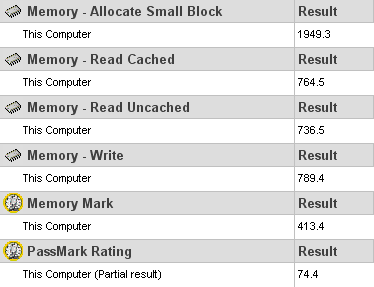
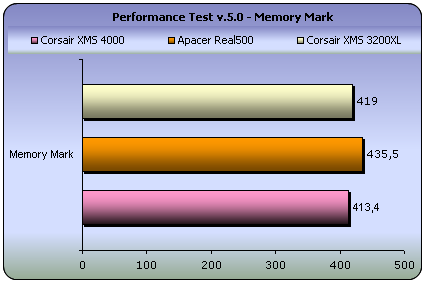
- Advanced Memory Benchmark
Memory Speed Per Access Step Size
The first test type, ‘Memory Speed Per Access Step Size’ accesses a large block, of memory in various sized steps. First, it runs through the block of memory sequentially, accessing every value. Next it runs through the same block again, except this time it accesses every second value. On this occasion, it runs through the block twice in order to access the same amount of data as the initial step. Next it runs through the same block again, except this time it accesses every fourth value and so makes four passes. And so on, until a certain maximum step size is reached.
The size of the block of memory used for this test is one quarter the amount of system RAM. The size of the steps varies from 1 (continuous sequential access), to one quarter the size of the block of memory ( i.e. one sixteenth of the system RAM ).
| Memory Speed (MB/Sec. per Step Size) |
| Corsair TwinX2048-4000PT |
| Block Read Speed |
18.70 |
| Block Write Speed |
22.79 |
| Apacer Real500 |
| Block Read Speed |
18.93 |
| Block Write Speed |
22.20 |
| Corsair XMS TWINX1024-3200XL |
| Block Read Speed |
20.54 |
| Block Write Speed |
23.81 |
Memory Speed Per Block Size
When a computer program wants to use a section of memory to store data, it makes a request to Windows for the amount of memory it requires. Windows allocates the memory to the program ( unless system resources are very low ) and returns to the requesting program the address of the first memory slot in the allocated block. It is possible that some programs may request very large amounts of memory. The ‘Memory Speed Per Block Size’ test like the ‘Memory Speed Per Access Step Size’ test, is composed of many steps. During each step of the test, PerformanceTest requests a block of memory and runs through the block measuring the average access time. However on each subsequent step the size of the requested memory is increased, until finally a block close to the size of the system RAM is requested. In this way it is possible to observe the different access speeds for the different sizes of blocks.
Typically it is possible to see very fast memory access for blocks which are small enough to fit entirely into the L2 RAM cache, and slower access times for larger blocks accessed from main RAM. In the case where system resources are low, swapping to the disk may even be required for very large blocks.
| Memory Speed (MB/Sec. per Block Size) |
| Corsair TwinX2048-4000PT |
| Block Read Speed |
172.80 |
| Block Write Speed |
215.44 |
| Apacer Real500 |
| Block Read Speed |
178.83 |
| Block Write Speed |
223.27 |
| Corsair XMS TWINX1024-3200XL |
| Block Read Speed |
179.43 |
| Block Write Speed |
223.90 |
As discussed previously, timings for the TwinX2048 memory made it look slower in this test. However, real-life performance is not represented truly in these graphs.

6. Half Life 2
 Half life 2 is no doubt the most anticipated pc game of all times.
Half life 2 is no doubt the most anticipated pc game of all times.
Physics - From pebbles to water to 2-ton trucks respond as expected, as they obey the laws of mass, friction, gravity, and buoyancy.
Graphics - Source's shader-based renderer, like the one used at Pixar to create movies such as Toy Story® and Monster's, Inc.®, creates the most beautiful and realistic environments ever seen in a video game.
AI - Neither friends nor enemies charge blindly into the fray. They can assess threats, navigate tricky terrain, and fashion weapons from whatever is at hand.

The Corsair 2BG memory and the Apacer 1GB memory operate at 500MHz and the boost in frequency has a direct effect on Half Life's frame rate.
7. Overclocking
As already mentioned, Corsair uses SAMSUNG's chipsets for their memory solutions, which are known to be good overclockers and exceptionally stable at higher voltages. For our overclocking tests, we experimented with different running frequencies and timings. In every test setting, we used MemTest to check the stability of the system, and we finally ended up with a good, stable system running at 554MHz.

What seems strange is that when trying to change the timings, even if we were to increase the timings (slower memory), we always came up with crashes and blue screens. But leaving timings to the former 3-4-4-10 setting gave us a system in perfect shape. We also had to increase the voltage to 2.9v to ensure stable RAM module operation at 554MHz.
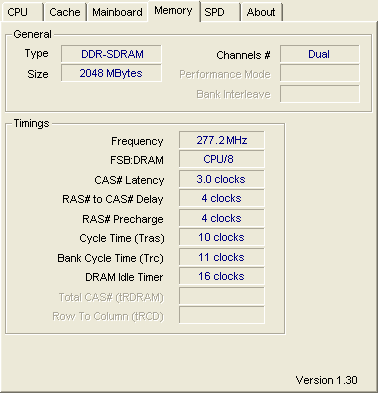
Even in an overclocked state, the memory modules are not that hot to touch. It seems that the heat spreaders attached to the chipsets are doing an excellent job. We could also go as high as 568MHz at 3.2v, but after leaving MemTest running for almost 4hours, the system became erratic.
We re-ran some tests with the the memory operating at 554MHz to see if there was any performance boost.





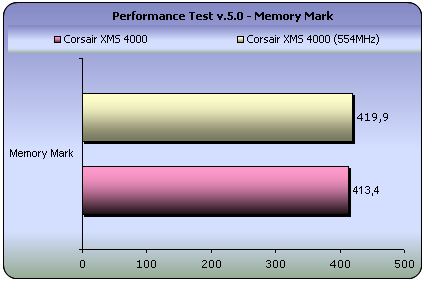
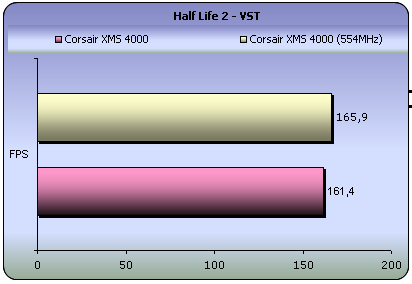
As you can see, although in most tests the performance improved, it is not worth the risk of damaging your system through over-voltage. For example, the 4fps gain in Half Life 2 for a RAM operating at 54MHz more than the default frequency is not that great.
On the other hand, it is worth noting that no other DDR memory could go that high in frequency, and overclocking potential is further increased when you finally see that these modules can really go as high as the motherboard can go.

8. Conclusion
 We were very fortunate to be given the opportunity to test the new Corsair 2GB paired memory modules. Even before performing a single test run with these modules, we were expecting to see some good performing RAM, since all the Corsair memory modules that we have tested in the past gave us very good results. However, this was the first time that we chose to test a 2GB memory set, since 1GB sets have been very popular.
We were very fortunate to be given the opportunity to test the new Corsair 2GB paired memory modules. Even before performing a single test run with these modules, we were expecting to see some good performing RAM, since all the Corsair memory modules that we have tested in the past gave us very good results. However, this was the first time that we chose to test a 2GB memory set, since 1GB sets have been very popular.
The Corsair TwinX2048-4000PT offer 500MHz operating frequency (3-4-4-8). This is one of the fastest operating frequencies that you can find for DDR memory. You should remember though, to manually change some BIOS settings in order to make this memory work at 500MHz. Of course, depending on your motherboard, changes may not be required.

We had no problems working in Dual Channel mode with the Corsair TwinX2048-4000PT. After all, as Corsair mentions, all Corsair matched memory pairs are double-checked to work in Dual Channel mode. In most tests that we have done, the TwinX2048-4000PT was the fastest memory.

If you are an overclocking geek, you would be happy to know that we had no heating problems when we overclocked this memory to 554MHz, and we got a stable system even without changing the timings. However, there was no major boost in performance. But after all, 500MHz is already enough, even for the more advanced users.

The Corsair TwinX2048-4000PT memory is priced at US$257.00 (from newegg.com), which is a small price to pay for one of the fastest memory pairs on the market.
The Good:
- Excellent performance at 500MHz
- Cool operation
- Very good price
The Bad:
- Must fiddle with the BIOS settings to get 500MHz operating frequency
